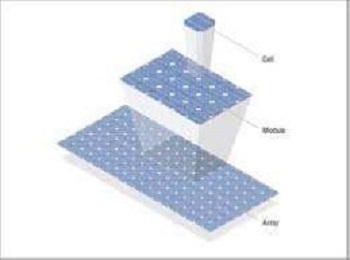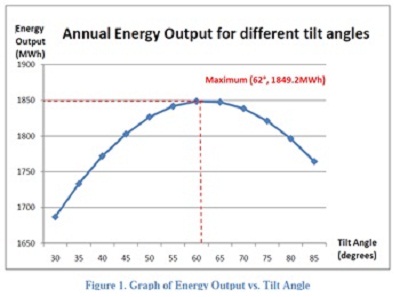Photovoltaic Panels Literature Review
Introduction
Photovoltaic technology operates by catching the photons of light and manipulating them to produce free electrons. These electrons generate an electric current. The main way to develop this technology is through solar power panels or PV cells. A PV cell is a semi-conductor cell which is able to convert solar rays into electrical power 1.
A Photovoltaic solar system is composed by three different elements, represented in the image to the right and detailed below.
Cell: The unit where the photon- electron energy transfer is going to happen.
Module or panel: The combination of several cells. The calculation of the main energy characteristics of these systems is usually referred to as the panel.
Array: The combination of various panels.

Types of Photovoltaic panels
There are a variety of solar panels based on semiconductor materials and manufacturing methods. Additionally, they can be classified according to their final shape 2.
Types of panels depending on the material and manufacturing process
The types of solar panels that can be found on the market related to the materials and manufactured process used are 3:
1. Monocrystalline Panels:
These panels are sections of a silicon bar in one piece crystallized perfectly. The efficiency of these panels does not reach more than a 24.7% in laboratory and a 16% for commercial ones. The Figure 2 shows a monocrystalline panel, the most common PV system.
2. Polycrystalline Panels:
Similar to the previous type but in this case the process of silicon crystallization is different. Polycrystalline panels are formed by pieces of a silicon bar that have been structured as disordered crystals. They are visually very recognizable because it presents a granulated surface. A lower efficiency than monocrystalline (19.8% laboratory and commercial modules 14%) is provided by these panel and consequently the price is also lower. This is the kind of panels selected for our case study.3. Amorphous Panels:
These panels have a considerable thickness. Using silicon with another structure or other semiconductor materials thinner and versatile panels can be obtained. In some cases these panels allow adaptation to irregular surfaces. They are called Amorphous PV Solar Panels or thin-film PV modules and they can be classified according to the material employed:
Amorphous Silicon (TFS):
Also manufactured with silicon, but differently from the previous examples. In this case the material does not have a crystal structure. Panels of this type are commonly used for small electronic devices (calculators, watches) and small portable panels. Its peak performance in the laboratory is roughly 13% and the commercial modules of 8%. Cadmium telluride, with a performance in laboratory of 16% and 8% in commercial modules. Gallium Arsenide is one of the most efficient materials with a 20% of efficiency on commercial panels.
4. Tandem Panels:
There are also Tandem panels, which combine two different types of semiconductor materials. Each type of material absorbs only a part of the electromagnetic spectrum of solar radiation and because of this a combination of two or three types of materials can be used to collect more than one of the electromagnetic spectrums. This type of panel can be as efficient as 35%.PV Sources
Operational system of a PV panel
The operation of the solar panels is based on the photovoltaic effect which occurs when solar radiation incidences in semiconductor materials (with a determinate internal structure and characteristics) producing electricity. During the period of exposure to solar radiation, the photons (basic particles of light and electromagnetic radiation) give their energy to electrons in semiconductor materials, and then these electrons can break the potential barrier of the pn-junction and exit through the semiconductor creating an electrical current 4. The solar cells are combined in many different ways to achieve both desired voltage and power.
The power of a Solar Panel is directly related to the peak power output, which represents the maximum power that a panel can generated in full sunlight 1.
Another important point for understanding the PV panels installation is the Tilt or angle of inclination of the panels in the roof. The best angle is around 30° from the horizontal (as per this information source)
Other factors as the temperature of the panels have not been taken into account due to the low temperatures reached in the UK. Nevertheless, the temperature of the panels is relevant in other region and must be considered; a reduction in the efficiency of the system can be produced is the temperature is too high 2.
Shown below is a chart detailing the optimum angle.

Incentives
Grants are available for the installation of PV Panels as detailed in the following webpage Government Grants UK. Please click on the following link to check current government grants check current government grants.
Renewables Obligation can be taken into account for the installation of a massive number of panels as detailed in the following website view Renewables Obligation.
Information about Feed-in Tariffs (FITS) can be found in the following websites view www.fitariffs.co.uk, and view DECC Feed-in Tariffs (FITS).
References
1. www.clean-energy-ideas.com/articles/photovoltaic_definition.html
2. www.sitiosolar.com/paneles%20fotovoltaicas.htm#Tiposdepaneles
© University of Strathclyde